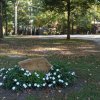Nation’s most prominent diver built notable Lewes house
In 1899, at age 52, Capt. Charles W. “Diver” Johnston contracted with a business partner - William H. Virden - to build a magnificent new house for himself and his wife, Isabella.
Records show that he paid $400 for the lot at 210 Savannah Road, one of the most prominent sites in downtown Lewes. In its first 100 years, the Queen Anne Victorian structure - built in the style of an English architect named Eastlake - served as a home for many families including longtime Lewes Mayor Otis Smith.
Hazel Brittingham, who at 90 said she knows just enough Lewes history to be dangerous, recalled that Smith lived in the house with his wife, Hazell, in the 1940s and early 1950s. “I believe that Bob Kennedy, comptroller for Otis’s Fish Products menhaden processing facilities, and his wife, Virginia, also lived in the house along with Virginia’s sister,” she said. They eventually all moved into other houses in Lewes and Rehoboth Beach, and other families took up residence in the imposing structure.
From the Johnston house, the Smiths moved to their new brick home on Gills Neck Road which in decades since has become known as the menhaden mansion.
The Savannah Road house served as a residence until it was purchased by Rick and Paulise Bell in 1994 as headquarters for his Harvard Business Services company. In most recent years, the building became home to Christine Hopkins’ Ocean Retreat Day Spa and sported a distinctive purple and lavender color scheme.
Now it’s been sold. According to the Jack Lingo Realtor sign in front of the building, the house is slated to become a restaurant this year.
Christina Bell wrote a history of the house after her parents bought the property. The Delaware Pilot newspaper also carried an article about Johnston and his new home in a special section published in 1902. Those articles detail the many successes enjoyed by the highly acclaimed marine salvager.
Highly sought skills
Johnston used the skills that led to his nickname to remove shipwrecks and dangerous rocky ledges from East Coast harbors and rivers extending from Maine to Florida, as well as from the Rio Grande and ports along the West Coast. Johnston succeeded where many other men failed. As a result, the federal government awarded him and his Johnston and Virden partnership dozens of contracts to remove impediments to maritime commerce. He also worked, in 1892, on construction of the Harbor of Refuge Breakwater in the mouth of Delaware Bay.
“In 1895,” according to Christina Bell’s history, “after four other firms failed to recover the steamer Wyanoke from the bottom of the James River near Newport News, Va., ‘Diver’ amazed even the most experienced dredgers by completing the job in 85 days.”
Before those successes, Johnston led one of the few unsuccessful ventures of his accomplished career. According to the Pilot article, Johnston, backed by a number of Philadelphia and New York capitalists, set out to locate the remains of the legendary HMS DeBraak and its mythical millions in gold. Despite months of dragging the ocean bottom off the point at Cape Henlopen, where the ship went down in a late-spring squall in 1798, Johnston’s efforts came up dry.
It wasn’t until the late 1900s that Harvey Harrington and another team of salvagers used side scan sonar to locate the DeBraak and raise her from the bottom. While some treasure was found aboard the ship, it was far less than the hoard inflated by two centuries’ worth of storytelling since its sinking.
Despite that lapse in success, Johnston continued winning government contracts totalling more than one million dollars, a vast amount of money more than 100 years ago.
The house on Savannah Road, now destined for dining instead of diving, stands as testament to Diver’s prowess as a marine salvager and businessman.





















































